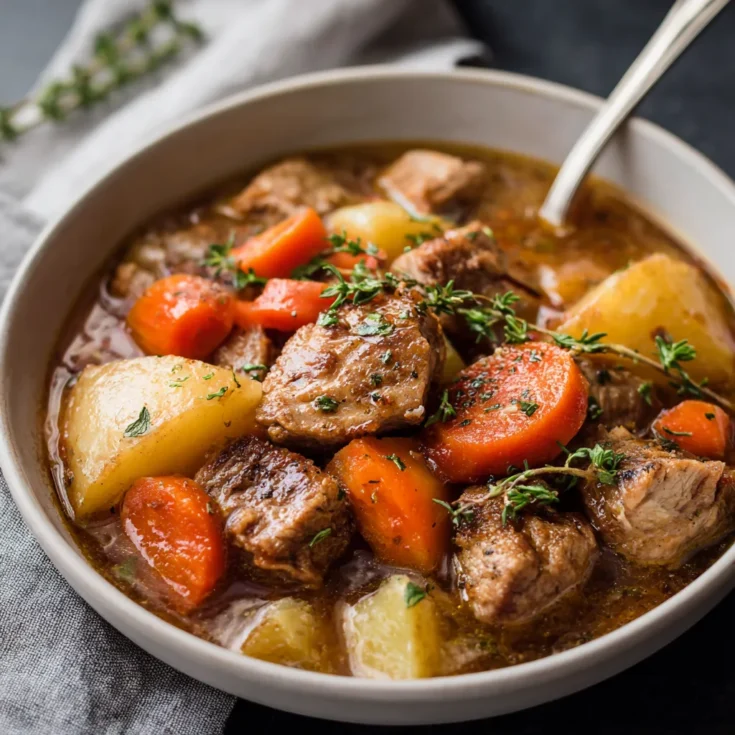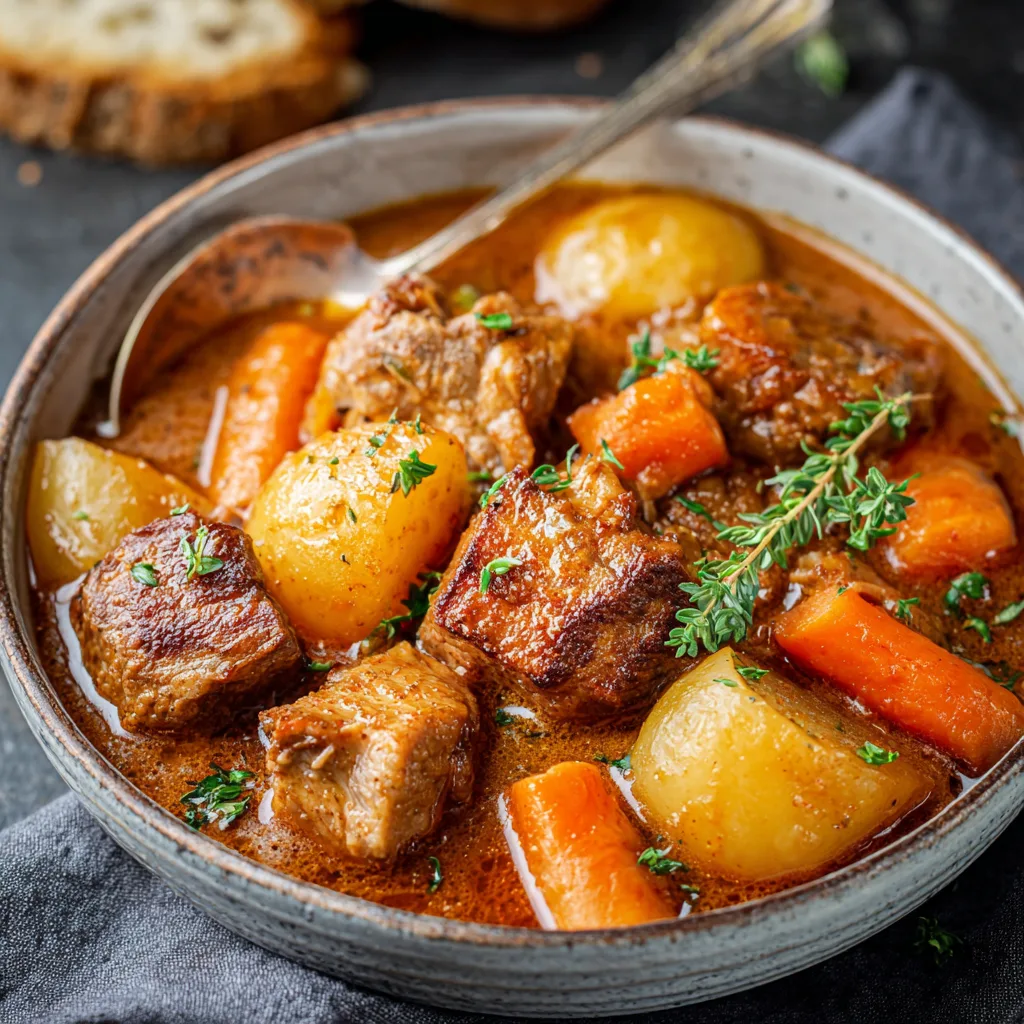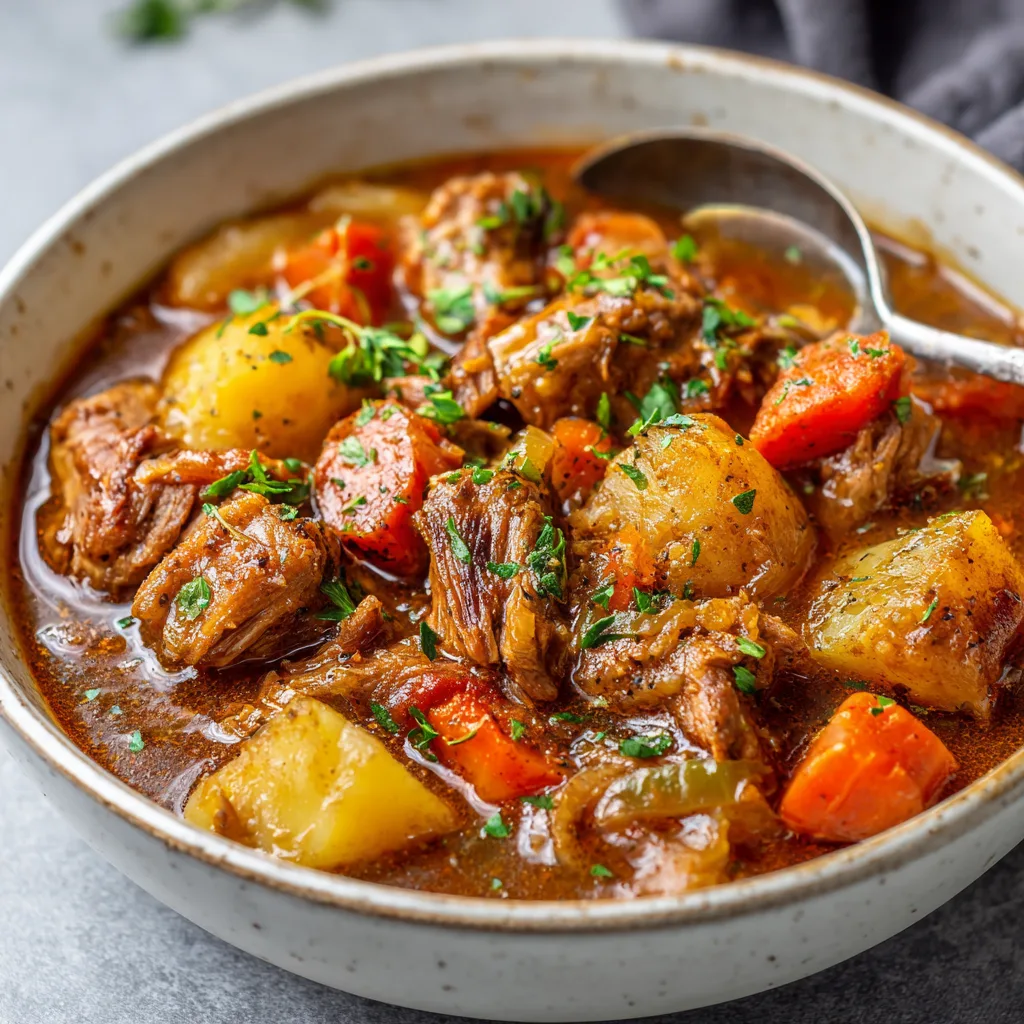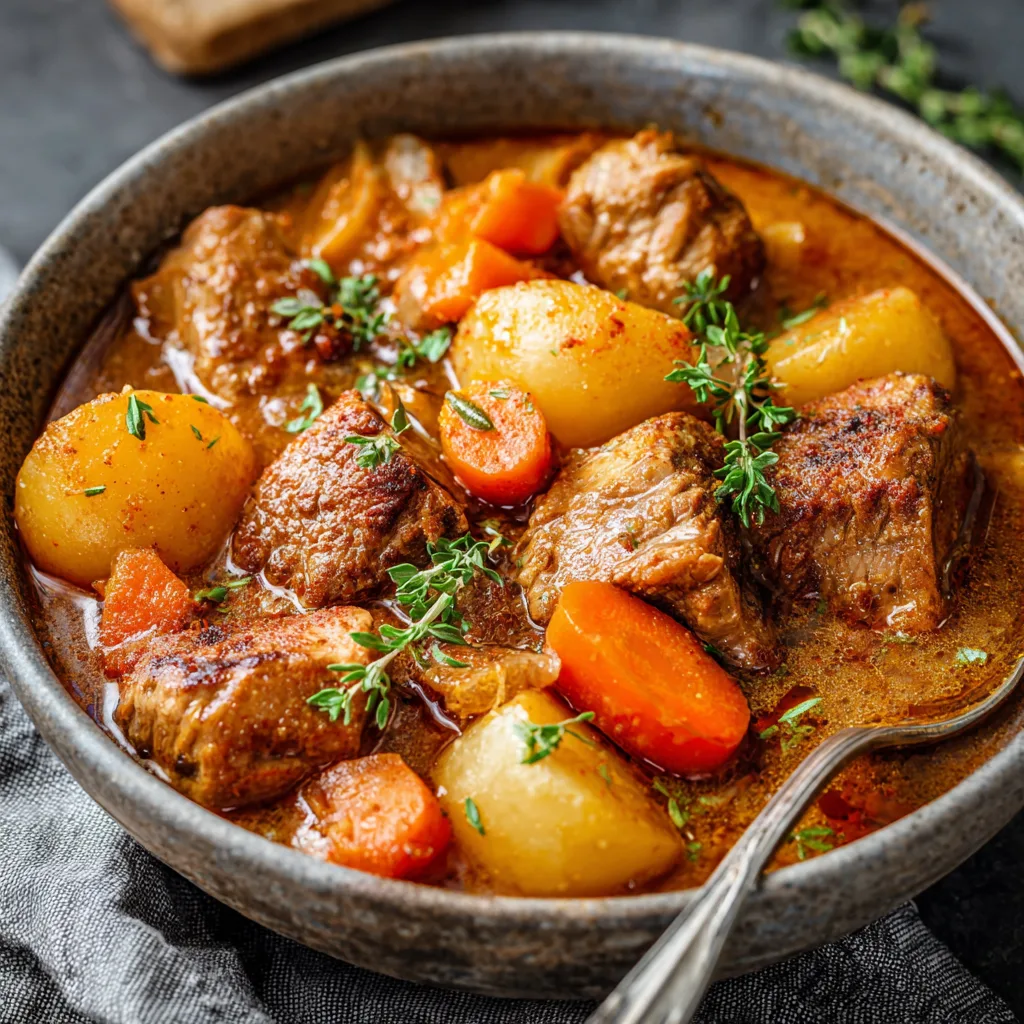Comfort Food Crockpot Pork Stew
When it comes to soul-warming meals, nothing satisfies quite like a hearty bowl of Crockpot pork stew. This dish delivers everything we crave in comfort food—tender meat, rich flavors, and nourishing vegetables—all slow-cooked to perfection. It’s not just a meal; it’s an experience. The kind that fills your kitchen with irresistible aromas and your table with satisfied smiles.
The beauty of this stew lies in its simplicity. With just a few staple ingredients and a slow cooker, you can create a cozy dinner without hovering over the stove. Pork shoulder takes center stage, becoming melt-in-your-mouth tender as it simmers alongside carrots, potatoes, and savory herbs. A well-balanced broth ties everything together, soaking each bite with deep, homestyle flavor.
Whether you’re looking to warm up on a chilly evening or feed a hungry family, this dish is both dependable and delicious. It brings the comfort of tradition with the ease of modern cooking. It’s more than just stew—it’s a slow-cooked hug in a bowl.
Why This Stew Is a Staple in Comfort Food
Crockpot pork stew earns its place as a comfort food classic for good reason. It’s a hearty, one-pot wonder that makes any mealtime feel like home. The combination of tender pork, root vegetables, and seasoned broth creates a deeply satisfying bite that sticks with you.
Beyond its flavor, this dish offers flexibility. You can tailor it to your taste or dietary needs. Love smoky spices? Try a southwestern pork stew. Prefer something bold and earthy? A Hungarian-style pork stew with paprika hits the spot. Following a specific plan? There are paleo-friendly or low-carb variations too.
From rustic to refined, each version brings something special. No matter the twist, the heart of the stew stays the same—nourishing, filling, and full of comfort. That’s why it’s been loved for generations and remains a go-to dinner solution today.
Slow Cooker Benefits
Using a Crockpot to make pork stew offers more than just convenience—it transforms simple ingredients into rich, flavorful magic. The slow-cooking process gently breaks down the pork, turning it incredibly tender without effort.
This method also gives vegetables time to absorb the broth, blending flavors and textures in every spoonful. Best of all, it’s a hands-off process. Just prep, set, and let your slow cooker do the work while you focus on your day.
For busy families, this cooking style is a game-changer. It’s stress-free, low-maintenance, and perfect for prepping ahead. When dinner time rolls around, you’ll have a hot, satisfying meal ready—no last-minute scrambling required.
Base Ingredients Breakdown
The heart of a great Crockpot pork stew lies in its foundational ingredients. Start with the right cut of pork, and you’ve already won half the battle. Pork shoulder or pork butt is the top choice here. These cuts contain more fat and connective tissue, which break down beautifully during slow cooking. The result? Fork-tender meat that melts in your mouth.
Some may consider leaner cuts like pork loin, but these tend to dry out over long cook times. If you prefer a firmer texture, a combination of pork shoulder and loin can offer balance. Still, for full-on comfort and flavor, pork shoulder remains the gold standard.
Classic stew vegetables—like carrots, potatoes, onions, and celery—bring body, color, and a rustic appeal. Carrots and potatoes absorb the stew’s rich broth while holding their shape. Onion and celery round out the flavor base. Want to switch it up? Add green peas, sweet potatoes, or beans for extra nutrients and color.
When it comes to liquids, broth is your best friend. Both chicken and beef broth work well, depending on the depth you desire. Chicken broth provides a lighter background, while beef broth adds richness. Tomato paste brings a subtle sweetness and thickness that enhances every spoonful. For added depth, you can also include a splash of broth-infused oil or a dab of butter, depending on your preference.
Flavor Agents & Seasonings
A well-seasoned pork stew brings every bite to life. Garlic and onion form the aromatic foundation, creating a savory base that steeps through the meat and vegetables. Bay leaves add a subtle, herbaceous layer that rounds out the overall flavor.
For seasoning, there’s room to be creative. Paprika is key for Hungarian-inspired stews, delivering both warmth and vibrant color. For a southwestern flair, try chili powder and cumin. These spices give your stew a smoky, slightly spicy twist that wakes up your taste buds.
Want your stew extra hearty? Use a thickener. A simple flour dredge before browning your pork not only locks in flavor but helps the sauce thicken naturally. Alternatively, a cornstarch slurry stirred in near the end of cooking will create a glossy, stew-like texture. Choose your method based on how rich and thick you like your final dish.
Common Variations & Dietary Adaptations
One of the best things about Crockpot pork stew is its adaptability. Whether you’re following a dietary plan or looking to experiment with flavors, this dish delivers.
For a Paleo or Whole30-friendly version, ditch the dairy and traditional thickeners. Instead, use a clean marinara base and load up on vegetables. This approach still offers a rich, comforting experience without straying from your goals.
Prefer something bold and earthy? A Hungarian-style pork stew brings intense flavor with sweet paprika, hearty vegetables, and a rich tomato-based sauce. Just skip the wine and let the seasonings do the heavy lifting.
Craving bold spices? Go southwestern with beans, corn, cumin, and chili powder. These ingredients transform your stew into a Tex-Mex masterpiece that pairs perfectly with warm cornbread or a side of rice.
Each variation offers its own personality, but the core stays the same: a deeply satisfying, slow-cooked comfort dish that works for every table.
Prep & Browning
Before the slow cooker does its magic, the pork needs a quick sear. This simple step boosts both flavor and texture. Start by cutting the pork shoulder into uniform cubes, then coat them lightly in flour mixed with salt and pepper.
Sear the pieces in a hot skillet until browned on all sides. This creates a flavorful crust and locks in moisture. It also helps thicken the stew later as the flour mixes with the broth. Skipping this step won’t ruin the dish, but taking a few extra minutes to brown the pork pays off in taste.
Crockpot Layering & Cooking Times
Layering the ingredients in the correct order ensures even cooking and optimal flavor. Begin by placing the seared pork at the bottom of the Crockpot. Next, add the chopped vegetables—onions, carrots, potatoes, and celery. Pour in your chosen broth and tomato paste. Sprinkle in your seasonings and aromatics.
For the best results, set the slow cooker on low for 6 to 8 hours. If you’re short on time, use the high setting for 4 to 6 hours. Both settings will yield tender pork, but the low-and-slow method deepens flavor. Add quick-cook ingredients like peas or corn in the last 30 minutes to prevent overcooking.
Avoid lifting the lid frequently, as it releases valuable heat and increases cook time.
Thickening & Finishing
Toward the end of cooking, check the stew’s consistency. If you prefer a thicker broth, you have options. A cornstarch slurry—two tablespoons of cornstarch mixed with two tablespoons of cold water—can be stirred in during the last 20 to 30 minutes. Let it simmer until the sauce thickens.
Another option is the flour dredge from earlier. It naturally thickens the stew as it cooks. If your stew feels too thick, simply add a splash of extra broth. For a rustic finish, mash a few potato chunks into the broth to add body without extra ingredients.
Step‑by‑Step Instructions
Follow these easy steps to make your Crockpot pork stew perfect every time:
-
Cut pork into chunks and pat dry.
This helps the seasoning and flour stick better. -
Coat pork in flour, salt, and pepper.
Adds flavor and thickens the stew naturally. -
Sear pork in a hot skillet until browned.
Browning boosts flavor and texture. -
Layer ingredients into Crockpot in order: pork, veggies, broth, tomato paste, seasonings.
Don’t stir; layering ensures even cooking. -
Cover and cook on low for 6–8 hours or high for 4–6 hours.
Avoid lifting the lid too often. -
Add peas or other quick-cook ingredients during the last 30 minutes.
Keeps them bright and firm. -
If needed, stir in a cornstarch slurry to thicken.
Let it cook uncovered for 20–30 more minutes. -
Taste and adjust seasoning before serving.
Add fresh herbs or a splash of broth as needed.
Each step supports flavor-building, from searing to seasoning to the final simmer.
Cooking Tips & Issues
Pork that’s tough after slow cooking often just needs more time. The collagen in shoulder cuts breaks down slowly. If your stew isn’t tender yet, give it another hour on low.
Avoid lean cuts like pork loin for this dish. They don’t hold up well in long cooking. Instead, choose well-marbled cuts for better results.
Overcooking can lead to mushy vegetables. To prevent this, cut root veggies into larger pieces and wait to add soft vegetables until the end.
Store leftovers in an airtight container in the fridge for up to five days. Freeze portions for up to three months. Reheat gently to preserve the stew’s texture.
Serving Suggestions
This Crockpot pork stew stands strong on its own, but the right pairing can take it to the next level. Soft, buttery dinner rolls soak up every drop of savory broth. Cornbread brings a subtle sweetness that balances the dish’s deep, savory flavors. If you’re after something traditional and hearty, Yorkshire pudding offers a crisp yet fluffy contrast that fits perfectly beside the stew.
Garnishes can elevate your bowl from simple to special. Sprinkle fresh parsley over the top for a pop of color and a clean, herbal finish. Want a smoky touch? Crumbled bacon adds crunch and richness. For those who like a kick, a few slices of jalapeño bring mild heat and a burst of flavor. These finishing touches let you personalize the dish for any occasion or preference.
This stew works just as well for casual weeknights as it does for cozy weekend gatherings.
Storage & Meal Prep
One of the biggest advantages of slow cooker pork stew is how well it stores. After cooking, let the stew cool to room temperature before transferring it to airtight containers. Store in the refrigerator for up to five days.
For longer storage, freeze individual or family-sized portions. In the freezer, the stew keeps its quality for about three to six months. Be sure to leave a little space in your containers, as the liquid will expand as it freezes.
When it’s time to reheat, you have options. On the stovetop, warm the stew over medium heat, stirring occasionally until heated through. In the microwave, use a microwave-safe dish, cover loosely, and heat in 1-minute intervals, stirring in between. You can also return the stew to the slow cooker on the “warm” or “low” setting until it reaches the right temperature.
This stew reheats beautifully, making it a great option for meal planning.
Batch Cooking & Freezing Tips
Crockpot pork stew is ideal for batch cooking. Make a double recipe and portion it out for the week. Use freezer-safe containers and label them with the date for easy organization.
To save time during busy weeks, freeze in meal-sized portions. This way, you can reheat only what you need. For best results, thaw overnight in the refrigerator before reheating.
If you’re prepping for a group or future meals, consider freezing the stew before cooking. Add raw ingredients (except broth) to a freezer bag and store flat. When ready, dump everything into the slow cooker, add broth, and cook as usual.
Batch prepping makes comfort food easy and convenient, any day of the week.
Frequently Asked Questions
What cut of pork is best for stew?
The best cut for Crockpot pork stew is pork shoulder or pork butt. These cuts contain enough fat and connective tissue to break down during long cooking, creating juicy, tender bites. Pork loin is a leaner option that holds its shape well but may turn dry if overcooked. For optimal texture and flavor, pork shoulder is your best bet.
How long should you cook pork stew in a Crockpot?
To achieve tender, flavorful pork, cook the stew on low for 6 to 8 hours or high for 4 to 6 hours. The longer, slower method develops deeper flavor and guarantees melt-in-your-mouth pork. If the meat still feels firm at the end of the cooking time, let it go for an extra hour on low.
Can you make pork stew spicy or sweet?
Absolutely! For a spicy version, add sliced jalapeños, red pepper flakes, or a pinch of chili powder. Want a sweeter twist? Stir in a small spoonful of brown sugar or add sweet potatoes to the vegetable mix. These simple ingredients allow you to tailor the flavor to your liking.
Is browning the pork before slow cooking necessary?
Browning the pork isn’t required, but it’s highly recommended. Searing the meat in a hot pan before adding it to the Crockpot creates a golden crust that boosts flavor. It also helps the stew develop a richer color and aroma. If you’re short on time, you can skip this step—but for the best taste, don’t.
Can I freeze pork stew?
Yes, pork stew freezes very well. Once cooled, portion it into airtight containers or freezer bags. It will keep in the freezer for up to three to six months. When ready to eat, thaw the stew overnight in the fridge and reheat gently on the stovetop or in the microwave.
Comfort Food Crockpot Pork Stew – Hearty, Tender & Easy to Make

This hearty slow-cooked pork stew combines tender pork, wholesome vegetables, and a savory, rich broth. Perfect for family dinners, meal prep, or cozy nights at home.
Ingredients
- 2½ lb pork shoulder, cubed
- 2 TB flour (or gluten-free substitute)
- 2 TB oil or butter
- 1 large onion, diced
- 5 garlic cloves, minced
- 4 carrots, peeled and chopped
- 2 celery stalks, sliced
- 1 lb potatoes, cubed
- 1 cup peas or beans (add later)
- 4 cups broth (chicken or beef)
- 2 TB tomato paste
- 2 bay leaves
- Salt and pepper, to taste
- Optional seasonings: paprika, cumin, chili powder
- 2 TB cornstarch + 2 TB water (for thickening slurry)
Instructions
Notes




